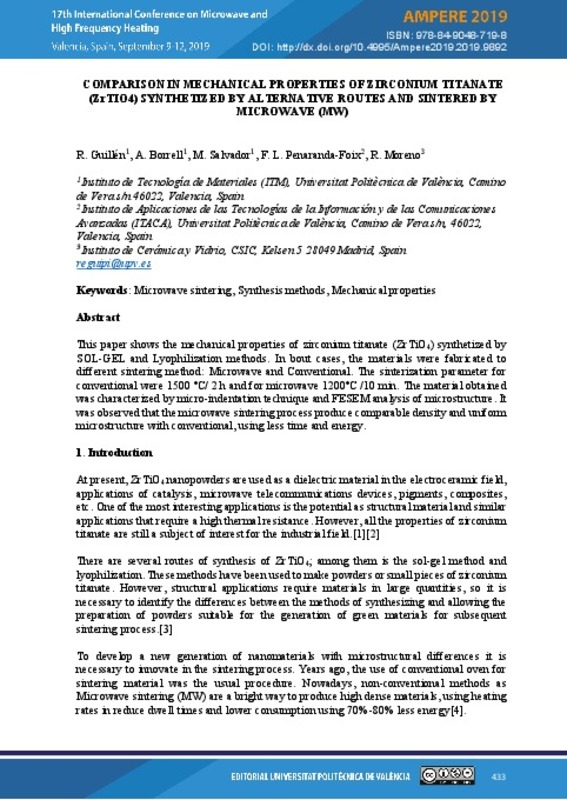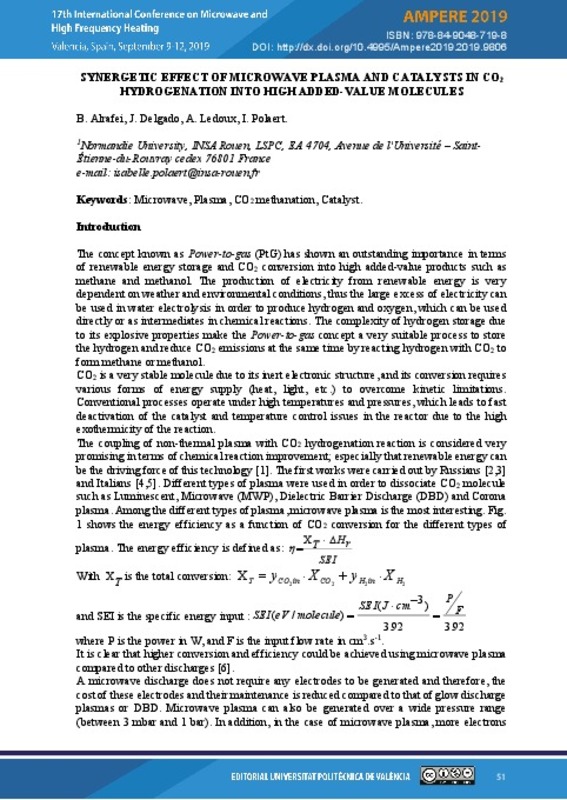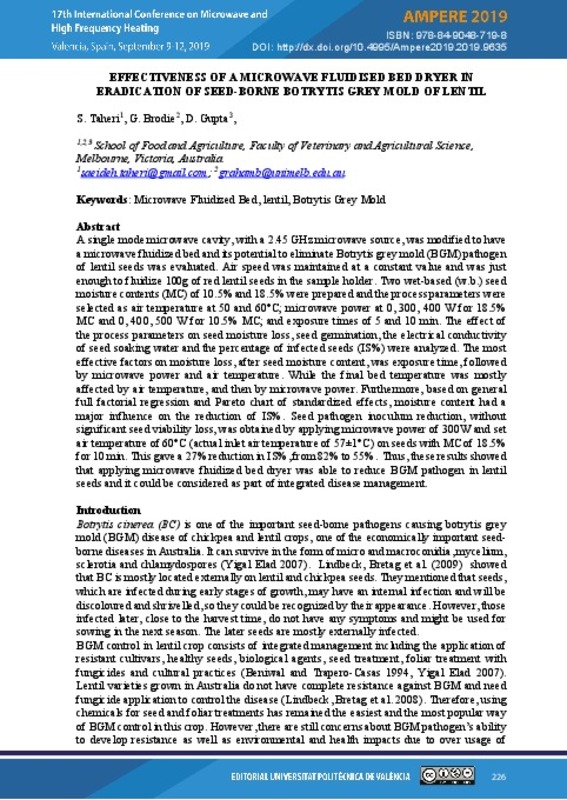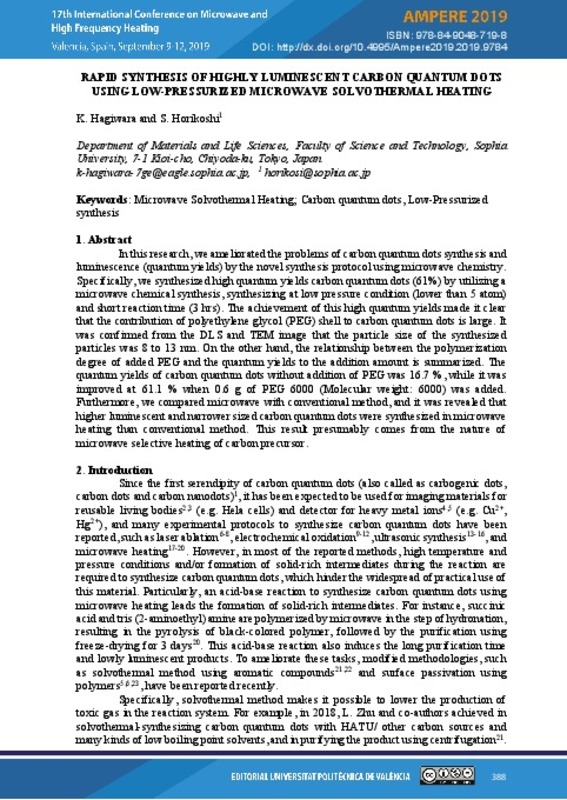JavaScript is disabled for your browser. Some features of this site may not work without it.
Buscar en RiuNet
Listar
Mi cuenta
Estadísticas
Ayuda RiuNet
Admin. UPV
Comparison in mechanical properties of zirconium titanate (ZrTiO4) synthetized by alternative routes and sintered by microwave (MW)
Mostrar el registro sencillo del ítem
Ficheros en el ítem
| dc.contributor.author | Guillén Pineda, René Miguel
|
es_ES |
| dc.contributor.author | Borrell Tomás, María Amparo
|
es_ES |
| dc.contributor.author | Salvador Moya, Mª Dolores
|
es_ES |
| dc.contributor.author | Peñaranda Foix, Felipe Laureano
|
es_ES |
| dc.contributor.author | Moreno, R.
|
es_ES |
| dc.date.accessioned | 2019-11-11T12:54:08Z | |
| dc.date.available | 2019-11-11T12:54:08Z | |
| dc.date.issued | 2019-10-15 | |
| dc.identifier.isbn | 9788490487198 | |
| dc.identifier.uri | http://hdl.handle.net/10251/130674 | |
| dc.description.abstract | [EN] At present, ZrTiO4 nanopowders are used as a dielectric in the electroceramic field, applications of catalysis, microwave telecommunications devices, pigments, composites, etc. One of the most interesting applications is the potential as structural material and similar applications that require a high thermal resistance. However, all the properties of zirconium titanate are still a subject of interest for the industrial field.12 There are several routes of synthesis of ZrTiO4; among them is the sol-gel method and lyophilization. These methods have been used to make powders or small pieces of zirconium titanate. However, structural applications require materials in large quantities, so it is necessary to identify the differences between the methods of synthesizing and allowing the preparation of powders suitable for the generation of green materials for subsequent sintering.3 To develop a new generation of nanomaterials with microstructural differences it is necessary to innovate in the sintering process. Years ago, the use of conventional oven for sintering material was the usual procedure. Nowadays, non-conventional methods as Microwave sintering (MW) are a bright way to produce high dense materials, using heating rates in reduce dwell times and lower consumption using 70%-80% less energy. 4 This reactive sintering technique achieves excellent mechanical properties, homogeneous microstructure employing lower sintering temperatures. All these energy and economic advantages generate a new vision for the future on ceramic materials and their industrial production. The main objective of this study is to make a comparison of the mechanical properties of the materials synthesized by sol-gel method and lyophilization and sintered by microwaves. | es_ES |
| dc.description.sponsorship | The authors would like to thank to the Generalitat Valenciana for financial support received for Santiago Grisolía program scholarship (GRISOLIAP/2018/168). A. Borrell acknowledges the Spanish Ministry of Economy and Competitiveness for her RyC contract (RYC-2016-20915). | es_ES |
| dc.format.extent | 6 | es_ES |
| dc.language | Inglés | es_ES |
| dc.publisher | Editorial Universitat Politècnica de València | es_ES |
| dc.relation.ispartof | AMPERE 2019. 17th International Conference on Microwave and High Frequency Heating | es_ES |
| dc.rights | Reconocimiento - No comercial - Sin obra derivada (by-nc-nd) | es_ES |
| dc.subject | Energy Production by Microwaves | es_ES |
| dc.subject | Microwave CVD | es_ES |
| dc.subject | EM Modelling | es_ES |
| dc.subject | Microwave Material interaction | es_ES |
| dc.subject | Dielectric Properties | es_ES |
| dc.subject | Dielectric Properties Measurement | es_ES |
| dc.subject | Solid State Microwave | es_ES |
| dc.subject | Microwave Processing | es_ES |
| dc.subject | Microwave Chemistry | es_ES |
| dc.subject | Microwave applicators design | es_ES |
| dc.title | Comparison in mechanical properties of zirconium titanate (ZrTiO4) synthetized by alternative routes and sintered by microwave (MW) | es_ES |
| dc.type | Capítulo de libro | es_ES |
| dc.type | Comunicación en congreso | es_ES |
| dc.identifier.doi | 10.4995/AMPERE2019.2019.9892 | |
| dc.relation.projectID | info:eu-repo/grantAgreement/MINECO//RYC-2016-20915/ | es_ES |
| dc.rights.accessRights | Abierto | es_ES |
| dc.contributor.affiliation | Universitat Politècnica de València. Escuela Técnica Superior de Ingenieros de Telecomunicación - Escola Tècnica Superior d'Enginyers de Telecomunicació | es_ES |
| dc.contributor.affiliation | Universitat Politècnica de València. Departamento de Ingeniería Mecánica y de Materiales - Departament d'Enginyeria Mecànica i de Materials | es_ES |
| dc.contributor.affiliation | Universitat Politècnica de València. Instituto de Tecnología de Materiales - Institut de Tecnologia de Materials | es_ES |
| dc.contributor.affiliation | Universitat Politècnica de València. Escuela Técnica Superior de Ingenieros Industriales - Escola Tècnica Superior d'Enginyers Industrials | es_ES |
| dc.contributor.affiliation | Universitat Politècnica de València. Departamento de Comunicaciones - Departament de Comunicacions | es_ES |
| dc.contributor.affiliation | Universitat Politècnica de València. Instituto Universitario de Aplicaciones de las Tecnologías de la Información - Institut Universitari d'Aplicacions de les Tecnologies de la Informació | es_ES |
| dc.description.bibliographicCitation | Guillén Pineda, RM.; Borrell Tomás, MA.; Salvador Moya, MD.; Peñaranda Foix, FL.; Moreno, R. (2019). Comparison in mechanical properties of zirconium titanate (ZrTiO4) synthetized by alternative routes and sintered by microwave (MW). En AMPERE 2019. 17th International Conference on Microwave and High Frequency Heating. Editorial Universitat Politècnica de València. 433-438. https://doi.org/10.4995/AMPERE2019.2019.9892 | es_ES |
| dc.description.accrualMethod | OCS | es_ES |
| dc.relation.conferencename | Ampere 2019 | es_ES |
| dc.relation.conferencedate | Septiembre 09-12,2019 | es_ES |
| dc.relation.conferenceplace | Valencia, Spain | es_ES |
| dc.relation.publisherversion | http://ocs.editorial.upv.es/index.php/AMPERE2019/AMPERE2019/paper/view/9892 | es_ES |
| dc.description.upvformatpinicio | 433 | es_ES |
| dc.description.upvformatpfin | 438 | es_ES |
| dc.type.version | info:eu-repo/semantics/publishedVersion | es_ES |
| dc.relation.pasarela | OCS\9892 | es_ES |
| dc.contributor.funder | Ministerio de Economía y Competitividad | es_ES |
Este ítem aparece en la(s) siguiente(s) colección(ones)
-
Ampere 2019 [66]
-
Artículos, conferencias, monografías [48357]











